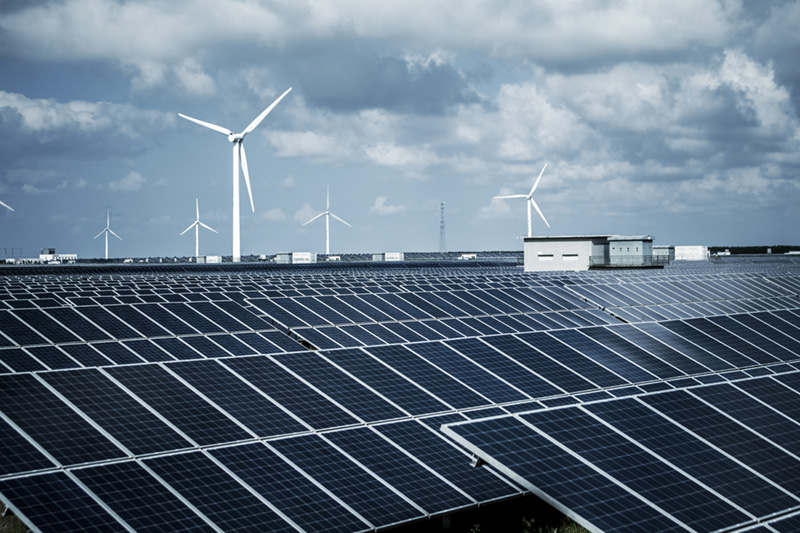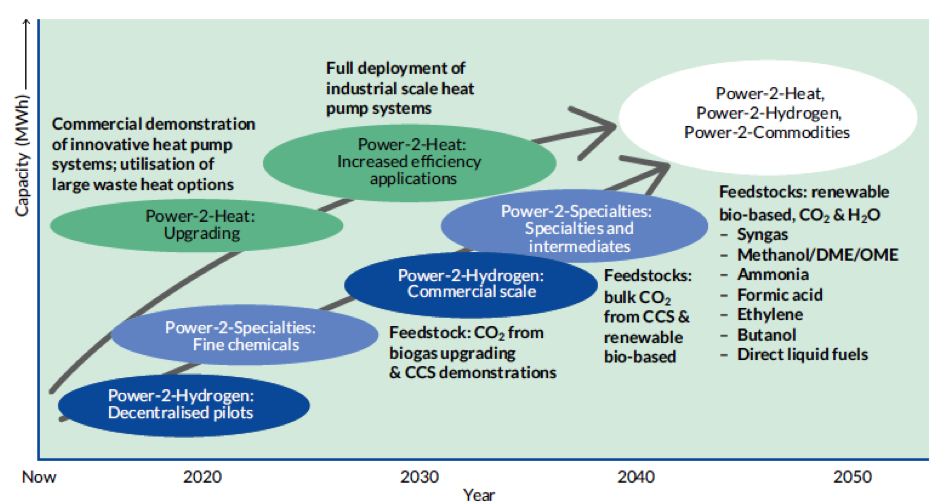

VoltaChem: Chemical industry plugs in
09-10-2016
 Electrification offers the Dutch chemical industry tremendous opportunities according to the white paper drawn up by the industry-wide VoltaChem innovation program. Is the chemical industry plugging in? Is it possible?
Electrification offers the Dutch chemical industry tremendous opportunities according to the white paper drawn up by the industry-wide VoltaChem innovation program. Is the chemical industry plugging in? Is it possible?
"We think so," says Martijn de Graaff of the VoltaChem team. "Society is facing a fundamental energy transition. There are tremendous opportunities for the chemical industry to enhance its competitive position and make it more sustainable at the same time."
The initiative for VoltaChem came from Top Sector Chemical Industry, which identified electrification as one of the three most important opportunities (along with the switch to biobased production and a focus on fine chemical specialty products with high margins). The Netherlands Organization for Applied Scientific Research (TNO) and the Energy Research Centre of the Netherlands (ECN) were commissioned to give tangible substance to the electrification process with the aid of a start-up grant of two million euros. Last year, exploratory discussions were held with representatives from the chemical sector, the electricity sector and equipment builders. Earlier this year, this resulted in a white paper which listed the possibilities and outlined a roadmap. "We are convinced that everyone can benefit if we fast-track innovation in the field of electrification in the Netherlands," says De Graaff who, in his capacity as TNO Industrie's business development manager, is working on VoltaChem.
Opportunities for the Netherlands
With electrification you can kill two birds with one stone. The use of renewable electricity instead of fossil fuels directly reduces the CO2 footprint of the chemical industry, but the industry can also deploy this electricity in a flexible manner to buffer fluctuations in the supply of solar and wind energy. Because this would remove some of the electricity sector's concerns, it could even promote more investment in renewable energy. Cooperation between the chemical and energy sectors thus results in a win-win situation. The Netherlands has plenty of opportunities in this respect, asserts De Graaff: it is densely populated and has wind turbine farms at sea, a strong concentration of chemical companies and a good knowledge infrastructure. "It is ideal for testing the application of electrification," he adds.
The VoltaChem white paper Empowering the chemical industry - Opportunities for electrification summarizes the possibilities which it has grouped in four concepts: power-2-heat, power-2-hydrogen, power-2-specialties and power-2-commodities. This order roughly reflects the timeline within which the various electrification options will be feasible. De Graaff: "In terms of sustainability, electrification of the bulk production of substances such as ethylene, methanol and ammonia would have the biggest impact. But that is for the long term. The great thing is that with power-2-heat and power-2-hydrogen we are already able to get cooperation with the electricity sector going in the short term."

Illustration: Roadmap for electrification in the chemical industry.
Bringing sectors together
De Graaff emphasizes the result-oriented nature of VoltaChem. "We want to identify cases which can be completed successfully within three to four years. What we have to ask ourselves is what is possible, when will it be possible and how will we realize it. The VoltaChem Community brings the electricity and chemical sectors together to answer these questions and to combine forces and put our shoulders to the wheel." The chemical sector could shift up a gear, as far as De Graaff is concerned. He has noticed that a number of forerunners are recognizing the opportunities and investing in them, but others are waiting to see which way the wind blows. "I understand that - keeping in mind international competition – there is a certain degree of caution, and the sharp drop in the oil price is not helping us either. Fortunately, interest is increasing and we have welcomed a considerable number of members to the VoltaChem Community in the last few months."
According to Reinier Gerrits, the Head of Energy and Climate at VNCI, the chemical sector is certainly aware of the possibilities of electrification. He is enthusiastic about the prospects sketched by VoltaChem. At the same time, he warns against excessively high expectations. "Ultimately, the important thing is to have healthy business cases. The industry will have to make additional investments in order to become more flexible. Whether they yield a return will depend on the profits resulting from the reduction in the imbalance in the electricity network. Even in the case of power-2-heat where, in theory, the best short-term possibilities lie, this is still often difficult." In the long term, electrification is definitely promising, in his opinion. "The industry will look very different in thirty years' time, of that you can be sure. More will be produced using biobased energy and there will also be more possibilities for power-2-chemicals, for example via electrochemistry, although that is going to require considerable development."
Power-2-heat: Generating or upgrading heat with electricity
Drivers for implementation: reducing costs and increasing sustainability.
This is an interesting business case, particularly for upgrading waste heat (with electrical heat pumps) and steam (via electrically driven mechanical vapor recompression). Temperatures of up to approximately 200 °C can be realized in this way. This makes it an attractive option because more than a third of the energy needed for heating in the chemical industry is used to produce temperatures within this range.
Compared with the burning of natural gas, the recycling of waste heat with power-2-heat technology can yield energy savings of up to 50% and thus reduce CO2 emissions considerably. VoltaChem has calculated the total reduction potential for the chemical industry at 6 megaton CO2 - provided solar or wind energy are used, of course.
Although power-2-heat does not enable a fundamental energy transition - it only gives a 'green shine' to processes which use fossil sources - it is certainly an interesting option in the short term. It gives the chemical industry the opportunity to present itself to the electricity sector as a direct 'buffer partner'. Dow Benelux has, for example, carried out a feasibility study into the upgrading of steam using mechanical vapor recompression. The results were favorable and Dow is now considering a pilot project. VoltaChem has calculated a maximum power-2-heat capacity of more than 1 gigawatt for the Netherlands, which is around a quarter of the current installed capacity of wind turbines and solar panels (and 4% of the capacity envisaged for 2030).
Power-2-hydrogen: production of hydrogen via electrolysis
Drivers for implementation: transition to sustainability and cost reduction (to a lesser extent).
Hydrogen is a much-used chemical raw ingredient which is almost all extracted from natural gas. The electrolysis of water with renewable electricity, on the other hand, yields 'fossil-free' hydrogen. As yet, the 'electrolysis route' is considerably more expensive than the 'fossil fuels route' because of the substantial investments needed for the technology. This difference may reasonably be expected to decrease. Germany, for example, is very active in this field, with a good number of demonstration projects. In the ELECTRE project, VoltaChem and partners such as Siemens and Hydron Energy are committed to improving the operational aspects of electrolysis technology with membranes (PEM electrolysis).
Methane can also be made from hydrogen after reaction with CO2, or ammonia after reaction with nitrogen. These options are often presented under the label of power-to-gas. Nuon, for example, is looking to convert surplus electricity into ammonia in the Eemshaven. In times of shortage of renewable electricity, the ammonia can then be utilized in the Magnum gas-fired power plant. But ammonia can also be used as chemical raw material, for example for the production of CO2-neutral artificial fertilizer. The ammonia route has been detailed in the power-2-ammonia project initiated by the Institute for Sustainable Process Technology (ISPT), which also counts VoltaChem as one of its project partners. The Dutch company Proton Ventures is also active in this field.
Power-2-specialties: production of high-quality chemical products via electrochemical synthesis
Drivers for implementation: new product possibilities and cost reduction (to a lesser extent).
The electrochemical approach promises greater purity and selectivity under relatively mild process conditions. Compared with existing processes, this often results in a reduction in by-products, waste products and energy consumption. It can, moreover, yield products which cannot be made in any other way.
In the field of biobased chemistry in particular, catalytic electrochemical conversion offers attractive possibilities for increasing product value. One example is the selective oxidation of hydroxymethylfurfural (HMF) to 2,5-Furandicarboxylic acid (FDCA).
The power-2-specialties approach is already being applied in a limited number of places in the Dutch chemical industry. In these cases, it concerns relatively small volumes of new products with high added value and alternative methods for inefficient traditional processes. The more comfortable margins on specialties provides relatively more leeway for innovation.
The expectation is that it will take five to ten years before electrochemical processes achieve a bigger share in the range of production methods. This will require the necessary development in the field of electrocatalytic conversion. The Netherlands has the requisite expertise in this field, particularly at the universities of Leiden, Delft, Utrecht and Twente. But to fully utilize the possibilities of electrification, research will have to be greatly expanded, according to VoltaChem.
Power-2-commodities: production of bulk products and energy carriers using electrochemistry
Drivers for implementation: transition to sustainability and cost reduction.
In the large-volume chemicals industry, we find far-reaching finalized processes and strong price competition with relatively tight profit margins. The need for sustainability will be the primary driver for investigating the possibilities for electrification. This could result from a business strategy in the field of social responsibility or because companies anticipate possible regulation.
It is difficult to develop positive electrification business cases in this sector. According to the VoltaChem white paper, however, there are possibilities in the medium to long term. In the first instance they will involve small-scale, decentralized production. This will yield a logistics advantage for bulk substances with a safety risk, such as hydrogen peroxide, or relatively high transport costs, such as fertilizers. The local availability of cheap or excess electricity is another important driver for such decentralized electrification.
There are, of course, already examples of centralized electrification being used, such as for the production of chlorine and the extraction of aluminum. In order to utilize electricity in carbon chemistry too, however, new processes will have to be developed. Electrocatalysis is the keyword here. The VoltaChem white paper mentions the electrochemical reduction of CO2 to products such as methane, carbon monoxide, ethylene and formic acid as examples. This may, for example, become attractive when large CO2 manufacturers such as steel and cement factories start searching for alternatives to the storage of greenhouse gas. In Germany, this has been elaborated in the Carbon2Chem project for which the German federal government recently made 60 million euros available. Dutch company Coval Energy is developing reactor technology for the electrocatalytic reduction of CO2 to formic acid, among other things.
Hydrogen obtained via the power-2-hydrogen route may also be a starting point for the sustainable synthesis of commodities. A crucial factor here is also to have cost-effective supplies of renewable carbon. Dutch company Torrgas thinks that it has found a solution for this. It has developed a process for making syngas, an important intermediate in the chemical industry, from biomass. As a result of a torrefaction (controlled partial pyrolysis) pretreatment of biomass, a high-quality tar and nitrogen-free biosyngas comprising hydrogen, methane, carbon monoxide and carbon dioxide is formed. Theoretically, a whole range of renewable products can be made from these substances in the traditional manner. Torrgas co-founder Robin Post van der Burg expects the construction of a 10-MW demonstration energy plant to commence next year in Delfzijl.
Source: Chemie Magazine, the Association of the Dutch Chemical Industry (VNCI)
Author: Harm Ikink, ElementC
Share this page: